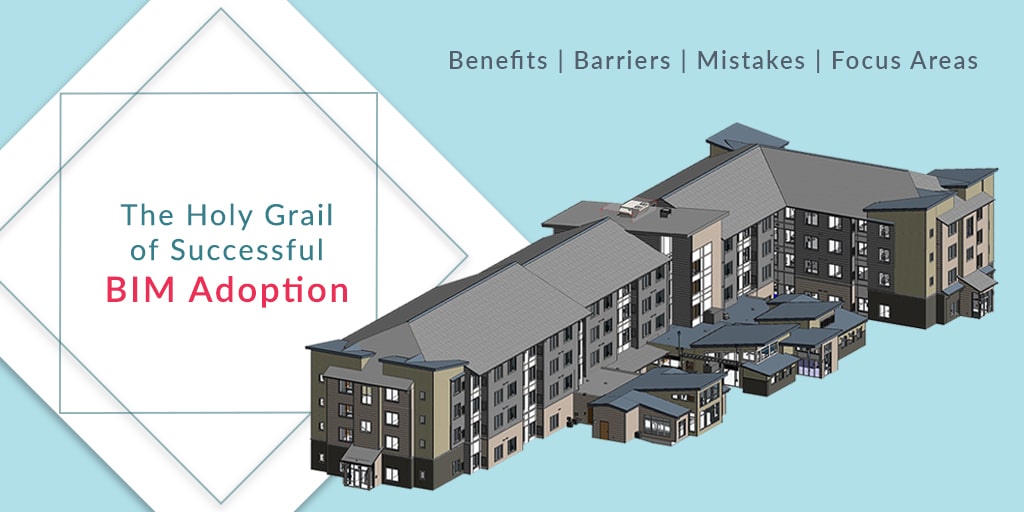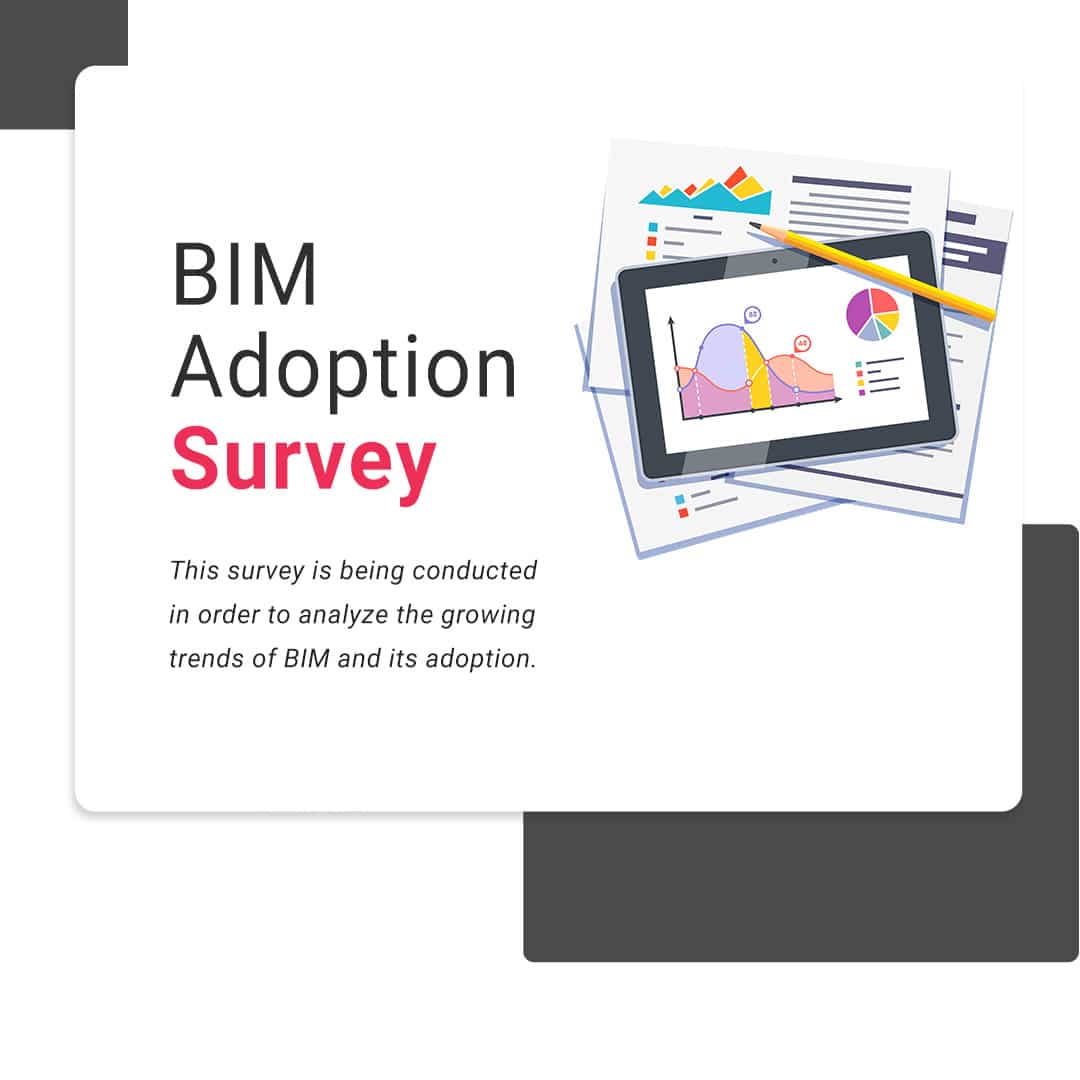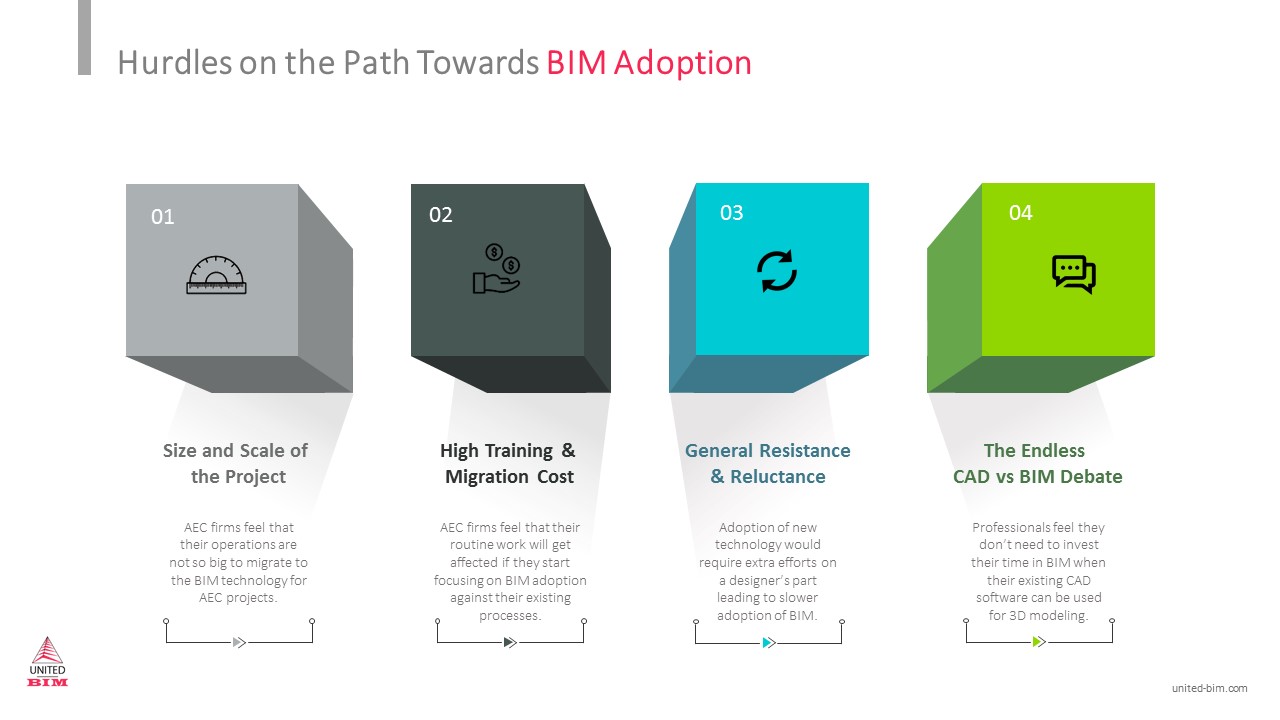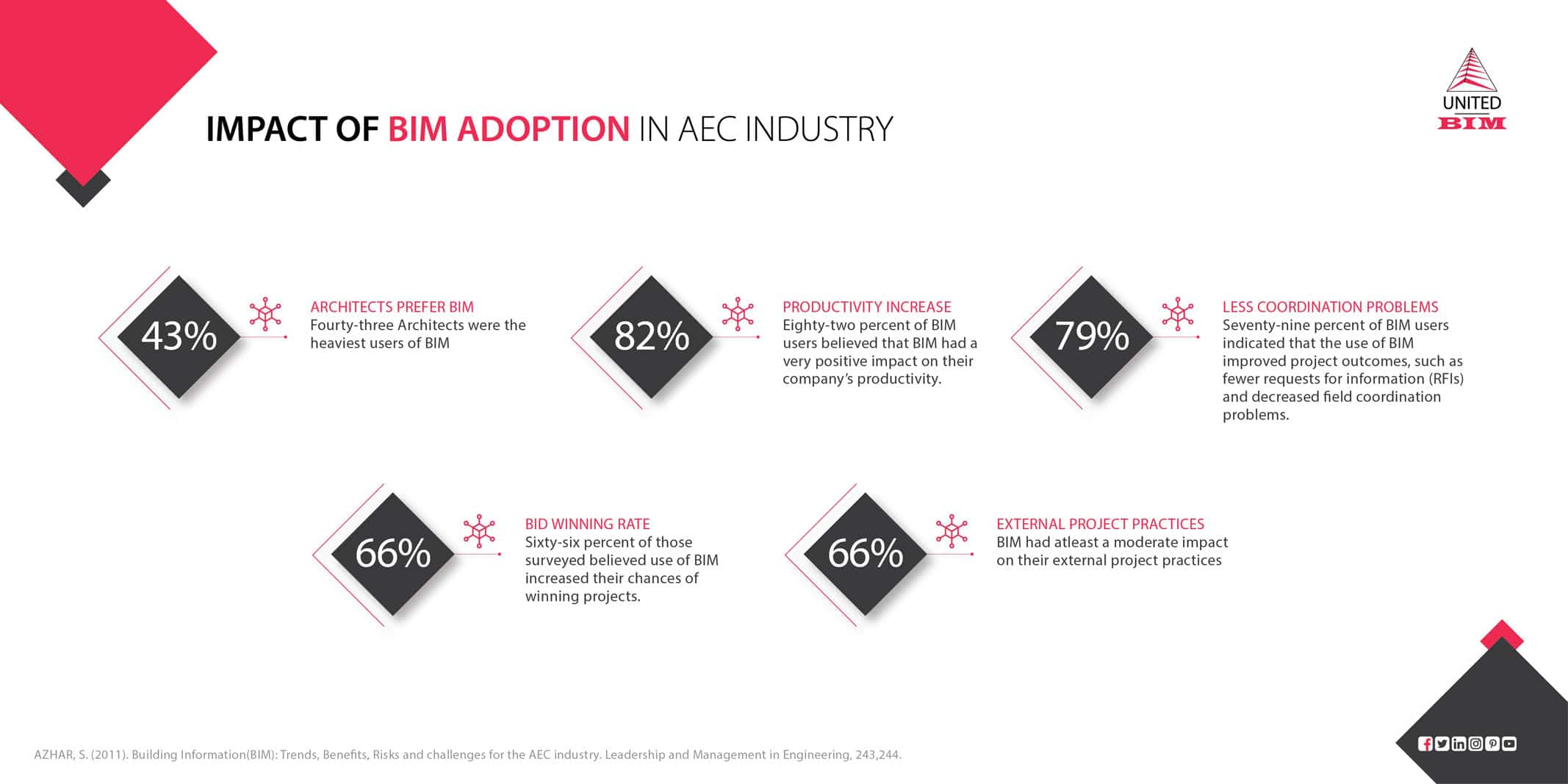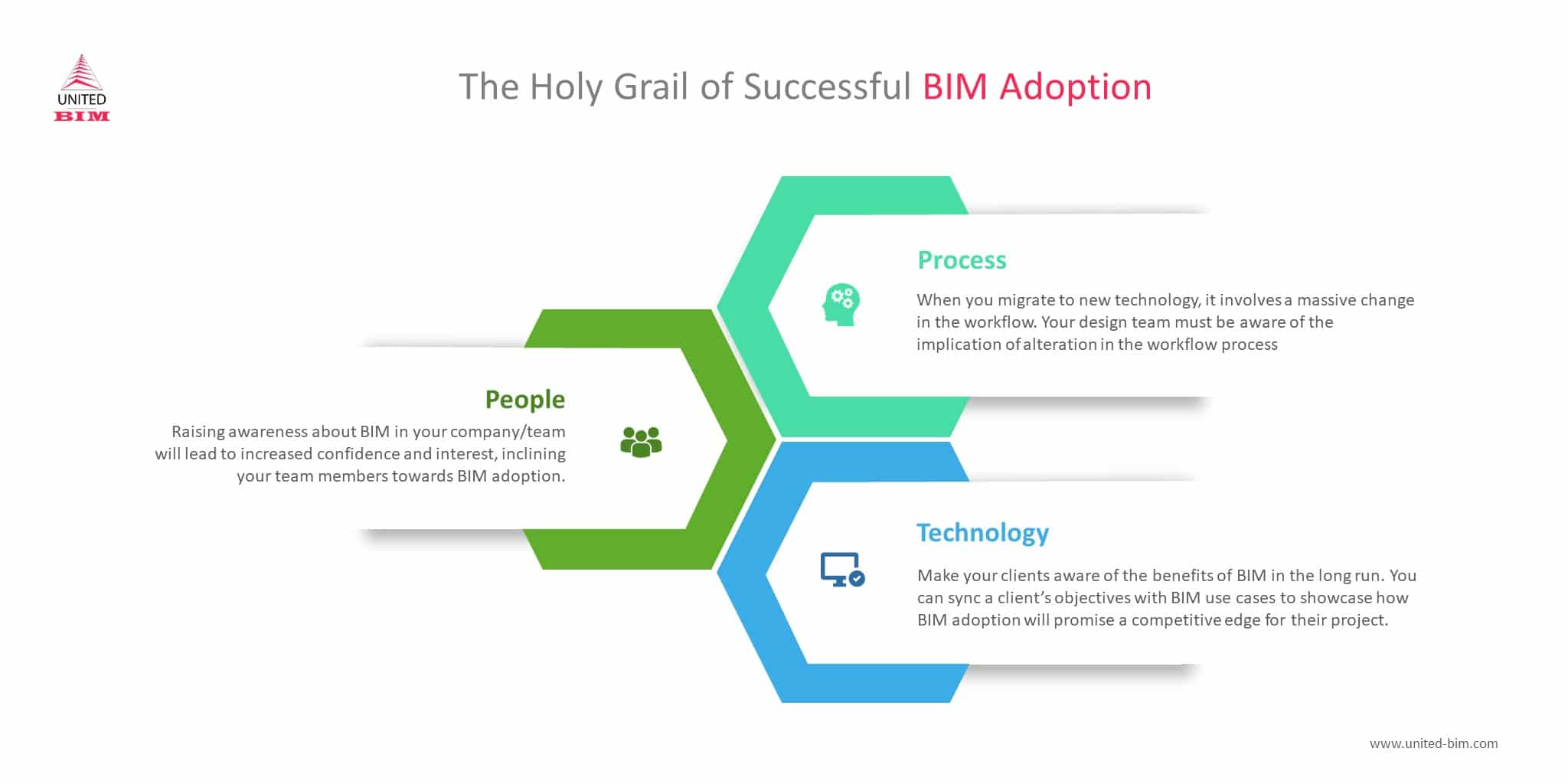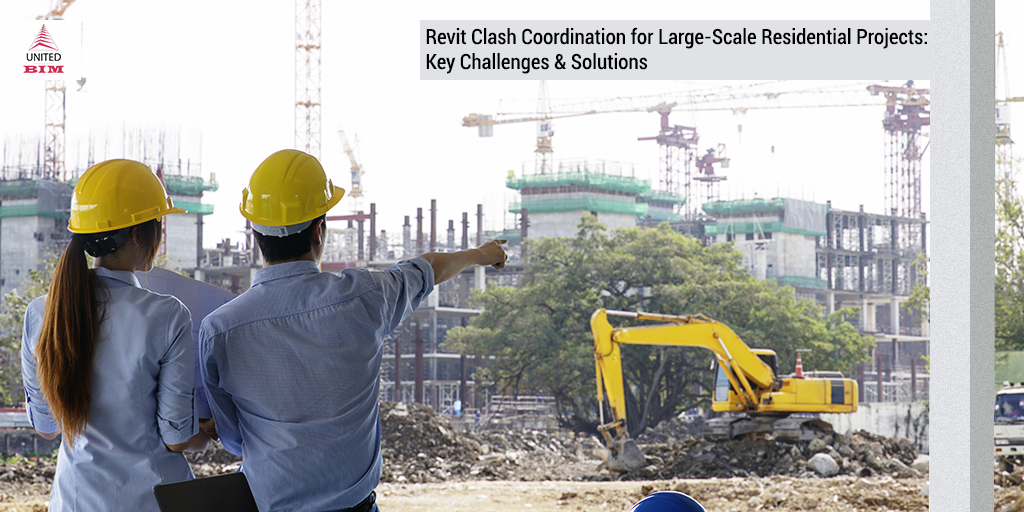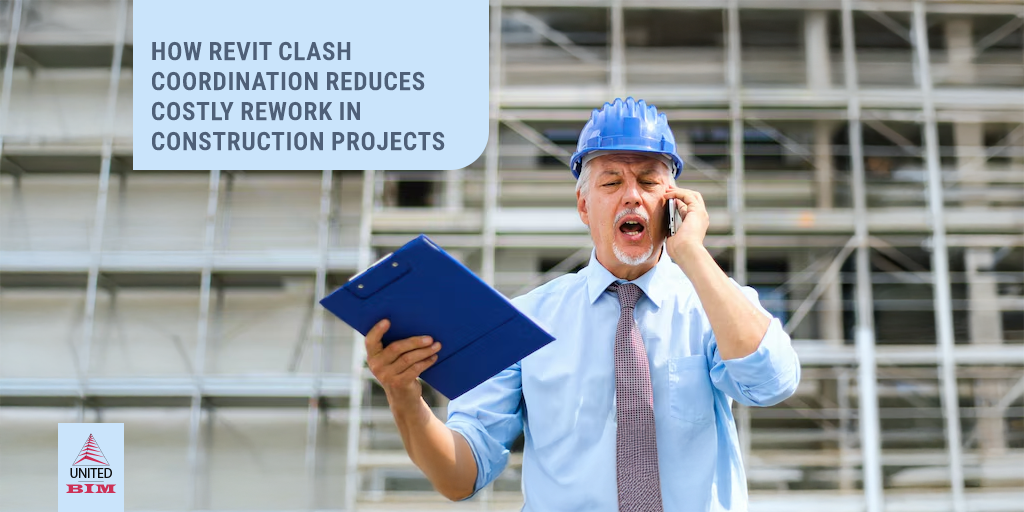Last updated on: January 7, 2025
Table of Contents
Overcoming the Barriers to BIM Adoption in the AEC Industry
The architecture, engineering and construction segment is moving towards digitization in the wake of increased concerns about optimal resource utilization, productivity, and profitability. Despite glaring interest towards digitization of the segment, BIM adoption faces several critical challenges and hurdles that are stopping the methodology to achieve its full potential.
BIM makes it easier for decision-makers to understand the design, cost and other aspects related to construction, still, the industry questions the efficacy of BIM implementation. Its no doubt that BIM is a valuable technology, but several factors are coming in way of large-scale adoption. Before we dig deeper into the BIM Challenges and slow pace of BIM, let’s look into why BIM is relevant in the modern AEC context.
Survey
With BIM adoption and implementation gaining momentum, it is imperative to review its process and improvise on the BIM structure constantly. This survey aims to not just evaluate answers but increase awareness of BIM as well as address concerns if any.
BIM: An Advantageous Approach to Construction Design
Conventionally, digitization is associated with using computer-aided design (CAD) techniques that involve the usage of computers for creating product designs and high-quality drawings. CAD software has been the industry standard for replacing the manual drafting of architectural drawings.
While CAD is a generic computer-aided design technique used for any type of design, BIM focuses on employing CAD concepts in the architectural and building design processes. Building information modeling is all about creating informative models of buildings that provide detailed information about the inherent properties of a building or structure about to get built.
In the words of the US National BIM Standard Project Committee, “BIM is a digital depiction of functional and physical characteristics of a structure. BIM, fundamentally, is a shared and reliable knowledge resource for information that can be referenced for decision making during the entire lifecycle- from concept stage to demolition.”
The BIM approach has several advantages over the CAD approach due to its inherent characteristics which promote insightful collaboration, detailed visualization, and cost-efficiency. Our insightful blog about the benefits of BIM highlights several other advantages of BIM adoption that would help you in making an informed decision. Using BIM instead of CAD approach is better for the AEC industry, in general.
According to the Stanford University Center for Integrated Facilities Engineering (CIFE) figures based on 32 major projects using BIM indicates benefits such as (CIFE, 2007):
Related Article: Why BIM Adoption is a must for General Contractors?
Hurdles on the Path Towards BIM Adoption
Despite being a beneficial proposition over conventional CAD techniques, BIM adoption is slower owing to several barriers and hurdles. These barriers limit the usage of BIM technology which can positively impact on a large scale in the AEC industry. Some of the barriers to BIM adoption are:
• Size and Scale of the Project
It is a common notion that BIM is only beneficial for large-scale projects with complex architecture and designs. AEC firms feel that their operations are not so big to migrate to the BIM technology for AEC projects.
However, that’s not entirely true. With tailored strategies, BIM can be scaled to fit the needs of projects of all sizes, delivering value regardless of their scope. United BIM’s experience has shown that even smaller projects can achieve improved efficiency and accuracy through BIM.
• High Training & Migration Cost
BIM implementation requires investment towards software as well as staff training. AEC firms feel that their routine work will get affected if they start focusing on BIM adoption against their existing processes.
But, this doesn’t have to be the case. We help streamline the process, providing hands-on support and practical training plans that minimize disruptions while ensuring your team is well-prepared to handle BIM effectively.
• General Resistance & Reluctance
Humans are resistive to change. They feel that what is working for them shouldn’t be disturbed and are often reluctant to step out of their comfort zone. The adoption of new technology would require extra efforts on a designer’s part leading to slower adoption of BIM.
To ease this, we focus on gradual implementation. By highlighting early successes and demonstrating tangible benefits, we help teams feel confident about embracing BIM without unnecessary pressure.
• The Endless CAD vs BIM Debate
Professionals in the AEC industry are known to compare CAD to BIM and feel that BIM is not worth their time. Often, professionals feel they don’t need to invest their time in BIM when their existing CAD software can be used for 3D modeling.
However, BIM offers much more than just 3D modeling. With advanced features like clash detection, centralized data, and enhanced collaboration, it bridges gaps that CAD cannot. We ensure teams fully understand these advantages through practical examples and clear outcomes.
Though there might be several other challenges and hurdles slowing down BIM adoption, it is important to understand the aspects that can accelerate the process of BIM adoption.
Learn more about our CAD to BIM Modeling Services
Managing Critical Focus Areas for BIM Adoption
01
PeopleThe first and foremost step towards moving ahead on the path to BIM adoption is to start investing in people. You need to clear their misconceptions about BIM and make them understand its benefits. Raising awareness about BIM in your company/team will lead to increased confidence and interest, inclining your team members towards BIM adoption despite the challenges of implementing BIM.
Tell them how their daily work will get simpler and better, making them more productive with BIM. Once they are adequately motivated, you can think of creating a training program for your team to kickstart the adoption process. Training sessions can be moderated and planned according to the adaptability of the team. Gradual learning and un-learning of latest modeling techniques not only enhance the awareness and exposure of individuals but also significantly boost team performance. This will improve their skill sets which will lead to better results in the long run.
02
ProcessNot only you are required to invest in people, but you also need to bring everyone on the same page about the adoption process. When you migrate to new technology, it involves a massive change in the workflow. Your design team must be aware of the implication of alteration in the workflow process and should thoroughly accept it. This can be a critical area to address in overcoming BIM challenges.
You can think of transitioning through a revolutionary or evolutionary approach. The revolutionary approach would involve scraping off everything you are doing- kicking out your old processes in favor of a completely new process. While the evolutionary process is more about protecting the segments that can be useful in the future and changing the steps that are no longer required. Both approaches have their pros and cons. Make sure to consult your team members before going with a revolutionary or evolutionary transition approach for workflow changes according to your long term vision.
03
TechnologyOnce you are set with people and process, you will need to channelize your focus towards technological aspects. You might have to update your existing IT infrastructure and bring in new software suites and tools when thinking of BIM adoption. Addressing the challenges of implementing BIM, such as upgrading infrastructure, is critical for successful integration.
At this stage, it is advisable to even make your clients aware of the benefits of BIM in the long run. You can sync a client’s objectives with BIM use cases to showcase how BIM adoption will promise a competitive edge for their project. This will ensure that your investment starts bearing fruits right from day one instead of waiting for clients to demand BIM.
These three aspects will help in overcoming several roadblocks and barriers to BIM adoption. Now that you know what to do, let’s enlighten you about the common mistakes that can tumble your BIM adoption dream. Precaution to these crucial areas can help you focus on the right segments.
8 Mistakes in BIM Implementation
While you might feel prepared to kickstart your BIM adoption journey, a lot of things can still go wrong if you aren’t careful. Having rich experience in the field of BIM, we have curated a list of common mistakes that BIM modelers and management make during the initial stages of BIM adoption.
- Lack of BIM implementation plan
- Hardware incompatibility
- Not focusing on information accuracy & precision in BIM
- Forgetting to upgrade the skill sets of your team members
- Over-modeling
- Over/underutilization of 3D content like Revit families
- Excessive use of third-party 2D content like PDFs and images in the model
- Forgetting to perform internal quality checks for improvement in architectural design
Now that you know the mistakes, don’t forget to read more about the tips to avoid BIM implementation mistakes in our informative blog that highlights all these issues and things you should do to prevent the same.
How United-BIM Can Help You in This BIM Adoption Process?
At United BIM, we are strong proponents of the advantages of BIM technology over other forms of building design approaches. We follow a consultative approach that augments the process of migration from traditional approaches to BIM-based approach. Having worked with organizations from multiple industries across all levels, we have helped them successfully transition toward BIM. Our first-hand experience endows us with information about what can go wrong, enabling us to handle the bottlenecks even before they arise.
Our standard quality practices like 3-Levels of Quality Checks and Drawing Review Checklist help us streamline and maintain the quality standard during BIM adoption. To achieve lean operational efficiency and speed, we have created a large repository of custom Revit families which might prove to be a distinguishing edge while working on large-scale construction projects. We can assist you in creating a custom Revit family library according to your project needs. Through our experience of working on more than 100 projects, we have identified that collaboration plays an integral role in BIM partnership. Using standard collaboration tools, and methods, we try to minimize the potential communication gap and provide holistic and efficient BIM services.
After reading this article, if you think we can assist you in your BIM implementation journey, we would be glad to collaborate on your next project. Get in touch with our BIM experts to know how BIM can be beneficial for your upcoming projects.
Related Article: How BIM can help a subcontractor?
BIM benefits projects of all sizes, improving completion speed, reducing errors, and enhancing collaboration.
To ensure successful BIM adoption:
• Have a clear plan with goals and roles.
• Provide proper training.
• Ensure data accuracy.
• Conduct regular quality checks.
To make a successful transition to BIM, organizations should:
• Create a detailed plan that outlines goals and deadlines.
• Offer continuous training and support to team members.
• Regularly track progress and make adjustments when necessary.
About the Author

Coordination Manager / VDC Manager at United BIM
With over 10 years of experience in the AEC industry, Akash Patel is a seasoned Coordination Manager and VDC Manager at United BIM. His expertise lies in managing complex MEP-FP coordination projects and leveraging cutting-edge BIM technology to ensure seamless collaboration and precision. Akash is dedicated to delivering high-quality, detailed models that meet the demands of modern construction. He is passionate about optimizing workflows and driving innovation within the BIM field.
